10 Colorful Annuals to Plant for Nonstop Blooms All Season Long
- Zinnias offer explosive color with minimal care. Plant these heat-loving flowers in full sun for continuous blooms in shades of red, orange, yellow, pink, and purple. Their sturdy stems make them perfect for cutting gardens, while their nectar-rich blooms attract butterflies and pollinators throughout summer and fall.
- Petunias deliver reliable waves of color from spring until frost. These versatile bloomers thrive in containers, hanging baskets, and garden beds, producing trumpet-shaped flowers in virtually every color except true blue. Newer varieties like Wave petunias spread up to 4 feet, eliminating the need for deadheading.
- Marigolds provide fool-proof flowers in sunny spots. Their golden, orange, and yellow blooms withstand summer heat and drought while naturally repelling garden pests. French marigolds offer compact growth with smaller blooms, while African marigolds produce large, showy flowers on taller plants.
- Impatiens brighten shady spots with non-stop color. These shade-loving annuals produce abundant blooms in white, pink, red, purple, and bicolor patterns. New Guinea impatiens offer larger flowers and improved sun tolerance, making them perfect for partly sunny locations where traditional impatiens might struggle.
- Calibrachoa (Million Bells) creates cascades of tiny petunia-like flowers. These prolific bloomers excel in hanging baskets and containers, requiring no deadheading to maintain continuous flowering. Their compact trailing habit produces hundreds of small blooms in vibrant hues, including unique patterns and bicolors.
- Cosmos delivers airy, daisy-like flowers with minimal maintenance. These drought-tolerant annuals bloom profusely in poor soil conditions, producing delicate blooms in pink, white, and crimson atop feathery foliage. Their tall, slender stems sway gracefully in summer breezes, creating movement in garden borders.
- Verbena spreads low-growing carpets of color throughout the season. These heat-tolerant flowers bloom continuously in purple, pink, red, and white clusters that attract butterflies and hummingbirds. Trailing varieties excel in hanging baskets, while upright types create colorful garden accents that withstand summer’s toughest conditions.
- Sunflowers offer dramatic height and cheerful blooms in any sunny spot. Beyond traditional yellow varieties, you’ll find burgundy, orange, and bicolor options that bloom continuously when you choose branching varieties. Pollenless types make perfect cut flowers, while multi-branching sunflowers produce dozens of smaller blooms on a single plant.
- Lantana delivers tropical color that thrives in heat and humidity. These drought-resistant plants produce multicolored flower clusters that change hues as they mature, creating a kaleidoscope effect in oranges, yellows, pinks, and purples. Their sturdy nature makes them perfect for hot, exposed locations where other flowers might fade.
- Sweet Alyssum creates fragrant carpets of tiny blooms from spring through fall. These low-growing annuals produce honey-scented white, purple, or pink flowers that spill over edges and fill garden gaps with continuous color. Heat-improved varieties maintain blooming even during summer’s hottest days, attracting beneficial insects to your garden.
Choosing Vibrant Petunias for Continuous Color

Petunias rank among the most dependable annuals for season-long color in your garden. These versatile bloomers offer an impressive range of colors, patterns, and growth habits that make them perfect for various garden settings. From borders to containers, petunias deliver continuous flowering with proper care.
Wave Petunias for Trailing Beauty
Wave petunias revolutionized gardening with their spreading, cascading growth habit that creates stunning displays in hanging baskets and garden edges. These vigorous bloomers can spread up to 4 feet and trail 2-3 feet, quickly covering large areas with vibrant flowers. Wave petunias require minimal maintenance—their self-cleaning ability eliminates the need for deadheading, allowing you to enjoy continuous color with less work. Available in purples, pinks, reds, and bicolor varieties, these weather-resistant plants recover quickly after rain. For best results, plant Wave petunias in full sun and ensure well-draining soil to prevent root rot while maintaining consistent moisture.
Supertunia Varieties for Heat Tolerance
Supertunias stand out as superior heat performers when summer temperatures soar. These powerhouse hybrids continue blooming profusely even when traditional petunias might falter in the intense heat. Bred specifically for resilience, Supertunias feature stronger root systems that help them withstand dry conditions and temperature fluctuations. Their self-cleaning nature means spent blooms drop automatically, ensuring continuous color without deadheading. Popular varieties include Vista Bubblegum with its vibrant pink flowers and Bordeaux with striking purple blooms featuring deep veining. For maximum performance, fertilize Supertunias every 1-2 weeks with a bloom-boosting fertilizer and provide at least 6 hours of direct sunlight daily to maintain their prolific flowering habit throughout the entire growing season.
Maximizing Blooms With Marigolds in Your Garden

Marigolds are garden powerhouses that deliver reliable color from spring until frost with minimal effort. These sun-loving annuals not only brighten your industry with their vibrant blooms but also serve as natural pest deterrents for your garden network.
French Marigolds for Compact Spaces
French marigolds (Tagetes patula) offer an ideal solution for smaller gardens, container plantings, and border edges with their compact growth habit reaching just 6-12 inches tall. These versatile bloomers produce abundant 1-2 inch flowers in rich gold, orange, mahogany, and bicolor patterns that continue throughout the growing season. For maximum flowering, plant French marigolds in full sun and space them 6-8 inches apart to allow for proper air circulation. Varieties like ‘Durango’ and ‘Bonanza’ deliver exceptional performance with their long-lasting blooms and disease resistance. Unlike some annuals, French marigolds actually perform better in average soil without excessive fertilizer, making them perfect low-maintenance options for busy gardeners.
African Marigolds for Bold Impact
African marigolds (Tagetes erecta) command attention with their impressive height of 2-3 feet and large, ball-shaped blooms measuring up to 5 inches across. These statement-making annuals produce flowers in brilliant yellow and orange shades that create dramatic focal points in garden beds or mixed borders. Plant African marigolds as backdrop plants behind shorter annuals or incorporate them into cutting gardens for long-lasting floral arrangements. Popular varieties like ‘Antigua’ and ‘Inca II’ deliver exceptional heat tolerance and continuous blooms when deadheaded regularly. For best results, space African marigolds 12-18 inches apart in well-draining soil and provide support for taller varieties in windy locations. Their bold presence and season-long performance make them indispensable for gardeners seeking high-impact color with minimal maintenance.
Incorporating Zinnia Varieties for Summer-Long Color
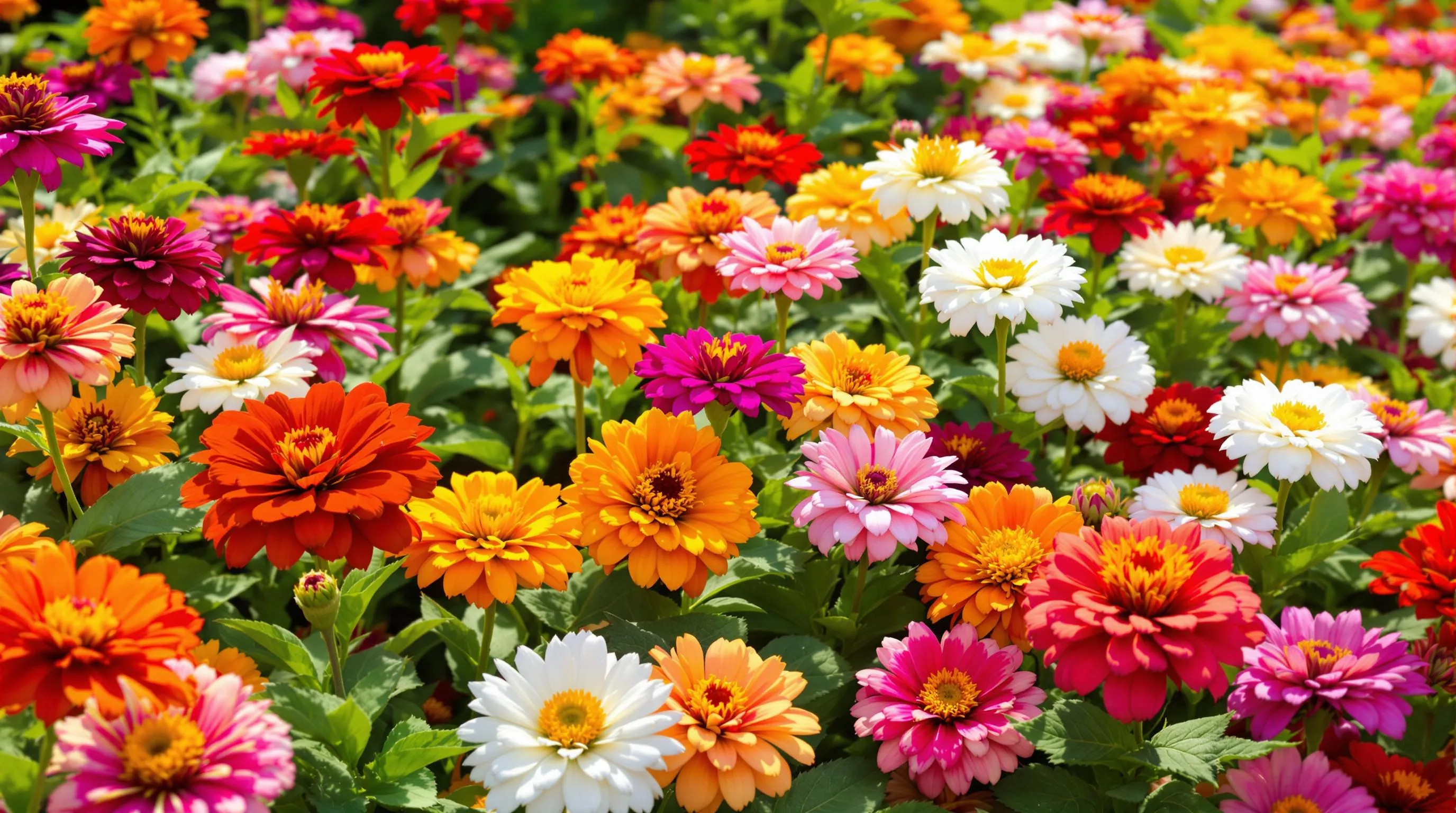
Zinnias stand out as some of the most rewarding annuals for gardeners seeking continuous color throughout the summer. These versatile flowers offer an impressive range of colors, sizes, and forms while requiring minimal care to deliver maximum impact.
Cut-and-Come-Again Zinnia Varieties
Cut-and-Come-Again zinnias are bred specifically for extended blooming periods, making them perfect for gardeners who want nonstop color. Harvest these varieties regularly to stimulate even more flower production—the more you cut, the more they bloom! The ‘Profusion’ series exemplifies this trait with its self-cleaning habit and disease resistance, producing 2-3 inch blooms in shades of cherry, orange, white, and yellow from early summer until frost. ‘Zahara’ zinnias offer similar benefits with exceptional mildew resistance, thriving even in humid conditions where other zinnias might struggle. For cutting gardens, plant ‘State Fair Mix’ or ‘California Giants’ which grow 3-4 feet tall and produce large 4-6 inch blooms that last remarkably well in arrangements while continuing to produce new flowers in your garden.
Heat-Resistant Zinnia Selections
Zinnias truly shine during the hottest days of summer when many other flowers fade. ‘Desert Sunrise’ and ‘Magellan’ series zinnias remain unfazed by temperature spikes, continuing to produce vibrant blooms even when thermometers climb above 90°F. The compact ‘Dreamland’ series offers excellent heat tolerance while staying under 12 inches tall, making them perfect for containers and front-of-border plantings. For truly challenging conditions, ‘Zahara Starlight Rose’ displays remarkable drought resistance alongside its heat tolerance, conserving water while maintaining continuous blooming. Plant these heat-lovers in full sun positions and provide moderate watering at soil level (avoiding overhead irrigation) to prevent fungal issues. Their resilience during summer’s most challenging months ensures your garden maintains its colorful display when many other annuals have given up.
Planting Cosmos for Airy, Abundant Flowers
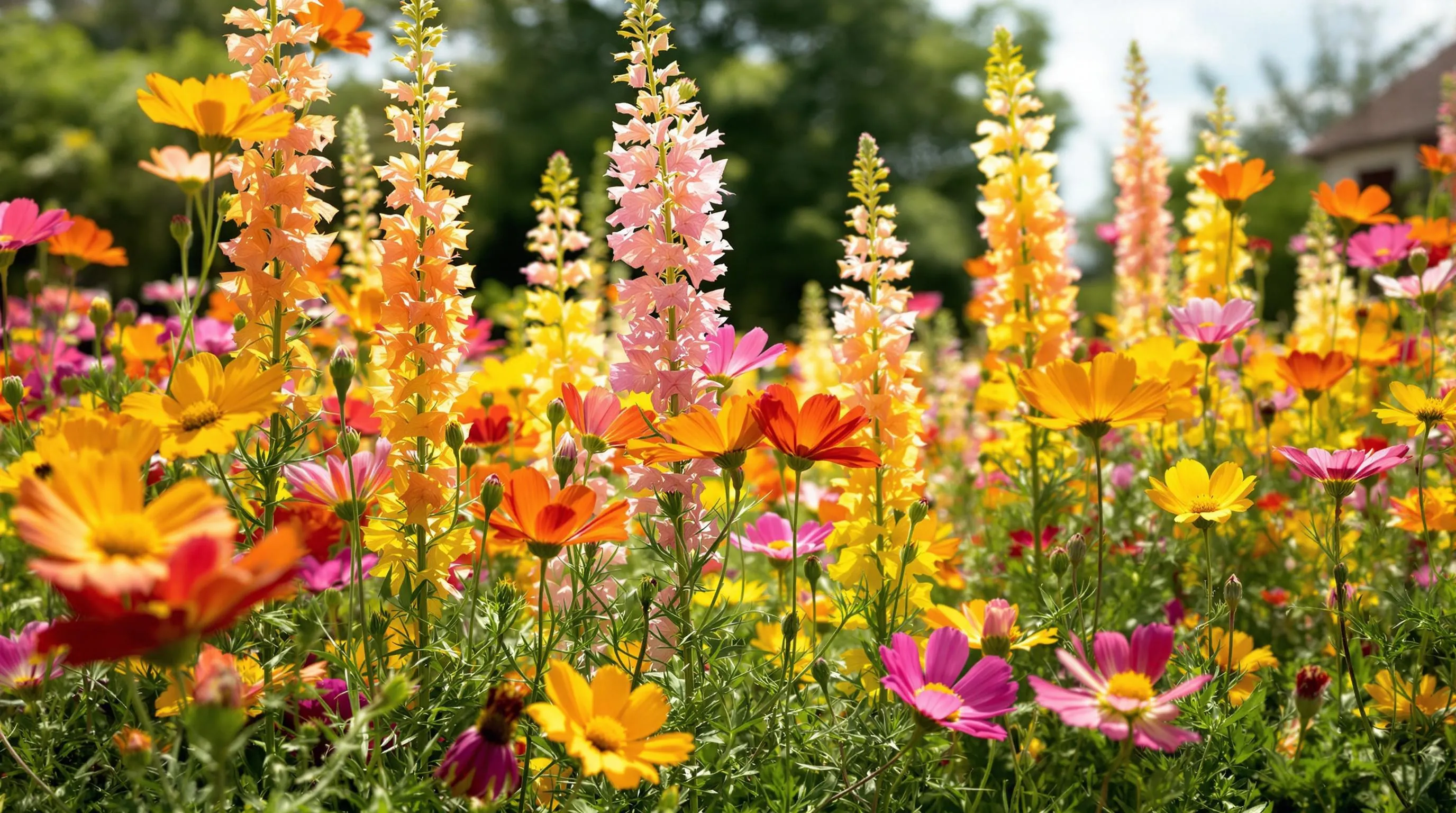
Cosmos are quintessential cottage garden annuals that deliver feathery foliage and daisy-like blooms with minimal effort. These drought-tolerant beauties thrive in average to poor soil and actually produce more flowers when not overwatered or overfertilized. Their tall, slender stems create a delicate, airy appearance that adds movement and texture to garden borders while providing continuous blooms from early summer until frost.
Cosmos Sulphureus for Hot Spots
Cosmos sulphureus, commonly known as orange cosmos or sulfur cosmos, is your go-to annual for scorching garden locations. These heat-loving plants produce vibrant orange, yellow, and red blooms that thrive when temperatures soar. Plant them in full sun with well-draining soil and watch them reach heights of 18-36 inches, creating brilliant splashes of warm color. Varieties like ‘Bright Lights’ and ‘Cosmic Orange’ deliver nonstop flowering with minimal maintenance—simply water them during extreme drought and avoid rich soil which produces leggy growth with fewer flowers. Their ability to self-seed makes them reliable returners each season, though you can easily control their spread by deadheading spent blooms.
Cosmos Bipinnatus for Cooler Areas
Cosmos bipinnatus, with its delicate pink, white, and magenta blooms, performs best in moderate temperature zones where it can flourish without extreme heat stress. These elegant flowers feature more finely-cut foliage than their sulphureus cousins and typically grow taller, reaching 3-5 feet in height. Popular varieties like ‘Sensation Mix’ and ‘Seashells’ offer unique petal formations that add distinctive charm to borders and cutting gardens. For continuous blooming, sow seeds directly in the garden after the last frost, spacing them 12-18 inches apart. Unlike many annuals, cosmos bipinnatus thrives in leaner soil conditions—fertilize sparingly to prevent excessive foliage growth at the expense of flowers. Their prolific blooming habit makes them excellent cut flowers, with each stem you harvest encouraging the plant to produce more blooms.
Using Calibrachoa (Million Bells) for Overflowing Containers
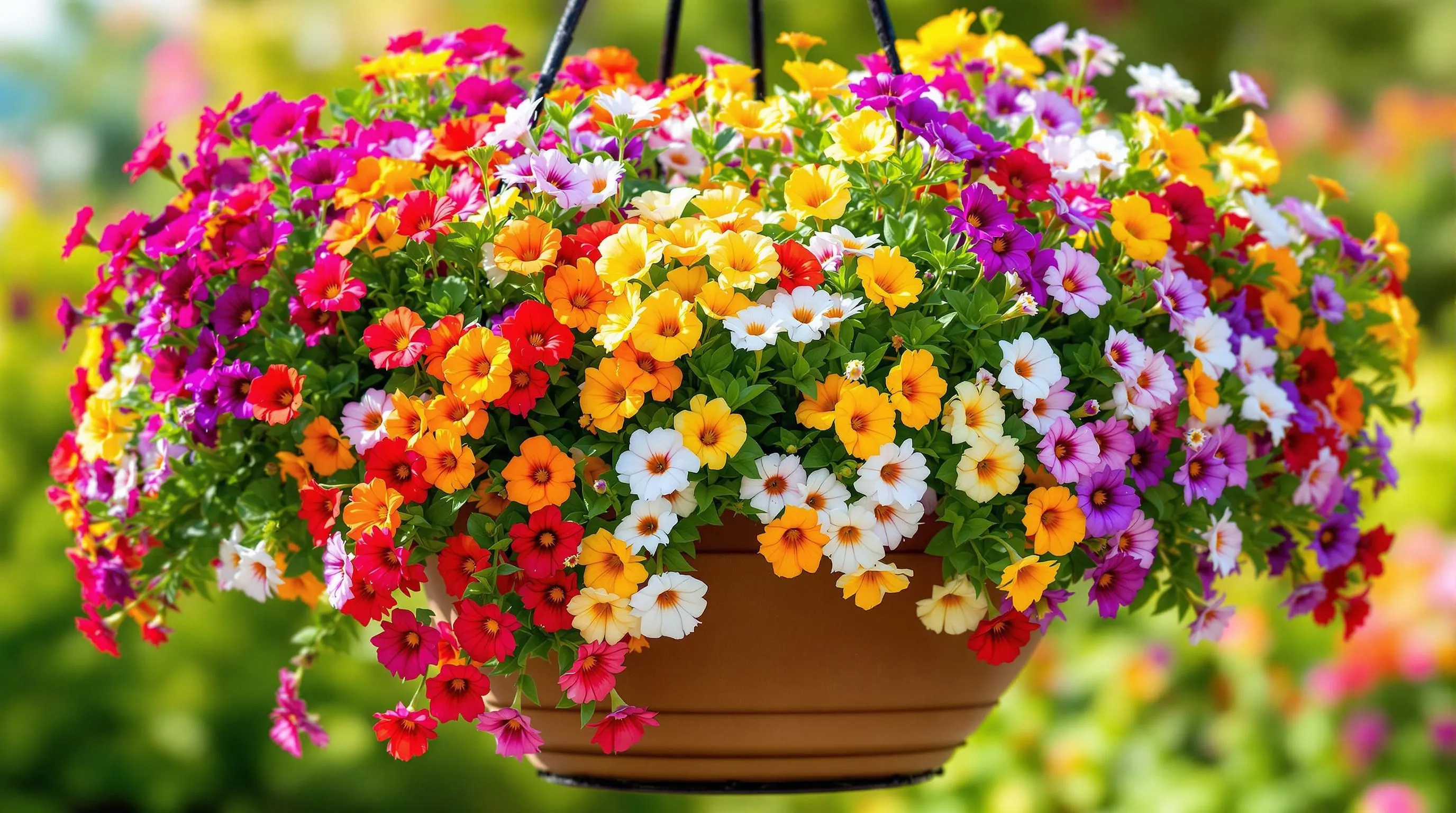
Calibrachoa, commonly known as Million Bells, offers gardeners an explosion of tiny, petunia-like blooms that continue from spring until frost with minimal maintenance. These compact powerhouses are specifically bred for container gardening, producing hundreds of colorful flowers on each plant without requiring deadheading. With their self-cleaning habit and impressive heat tolerance, Million Bells create instant impact in any container garden.
Trailing Varieties for Hanging Baskets
Trailing Calibrachoa varieties transform ordinary hanging baskets into spectacular cascading displays of color. The Superbells® series and MiniFamous® collections offer exceptional trailing habits, extending up to 2 feet in length when properly cared for. Plant these varieties in well-draining containers and position them where their trailing stems can spill freely over edges. For maximum impact, pair complementary colors like ‘Superbells Yellow’ with ‘Double Blue’ or create monochromatic baskets using varying shades of pink or purple. Apply a slow-release fertilizer at planting time and supplement with weekly liquid fertilizer to fuel their continuous blooming power throughout the season.
Upright Varieties for Mixed Planters
Upright Calibrachoa varieties serve as perfect “thriller” components in container combinations. The Cabaret® and Can-Can® series maintain a more compact, mounded habit that reaches 8-12 inches tall, making them ideal for the center or middle layer of mixed planters. Combine upright Million Bells with complementary annuals like spike dracaena for height, sweet potato vine for additional trailing interest, and diamond frost euphorbia for airy texture. These varieties particularly shine in sunny locations where their vibrant colors—ranging from deep cherry red to sunshine yellow and striking bicolors—can truly pop. Water consistently but allow the top inch of soil to dry between waterings to prevent root rot and encourage stronger blooming.
Growing Impatiens for Consistent Shade Blooms

Impatiens remain the go-to annual for transforming shady garden spots into colorful retreats. These shade-loving plants deliver reliable, continuous blooms from spring until frost with minimal maintenance, making them perfect for gardeners seeking vibrant color in challenging low-light areas.
New Guinea Impatiens for Disease Resistance
New Guinea impatiens offer superior disease resistance compared to traditional varieties, particularly against the devastating downy mildew that plagued common impatiens in recent years. These robust plants feature larger, more vivid blooms and glossy, sometimes variegated foliage that adds visual interest even between flowering cycles. Plant New Guinea impatiens 12-15 inches apart in rich, well-draining soil for optimal growth. Varieties like the ‘Divine’ series and ‘Infinity’ collection deliver exceptional performance with their self-cleaning habit, eliminating the need for deadheading while maintaining a tidy appearance throughout the growing season.
SunPatiens for Sun-Tolerant Options
SunPatiens revolutionize how you can use impatiens in your garden by thriving in both sun and shade conditions. These vigorous hybrids combine the best traits of traditional impatiens with remarkable heat tolerance, allowing you to plant them in areas that receive direct sunlight for part of the day. SunPatiens produce larger, more abundant flowers than standard impatiens and grow substantially bigger—up to 36 inches tall and wide. Their drought resistance makes them more forgiving if you occasionally forget to water, though consistent moisture produces the best results. Available in compact, spreading, and vigorous growth habits, SunPatiens create stunning mass plantings in beds or serve as spectacular container specimens with their continuous, vibrant blooms from spring until the first hard frost.
Adding Verbena for Heat-Tolerant Spreading Color
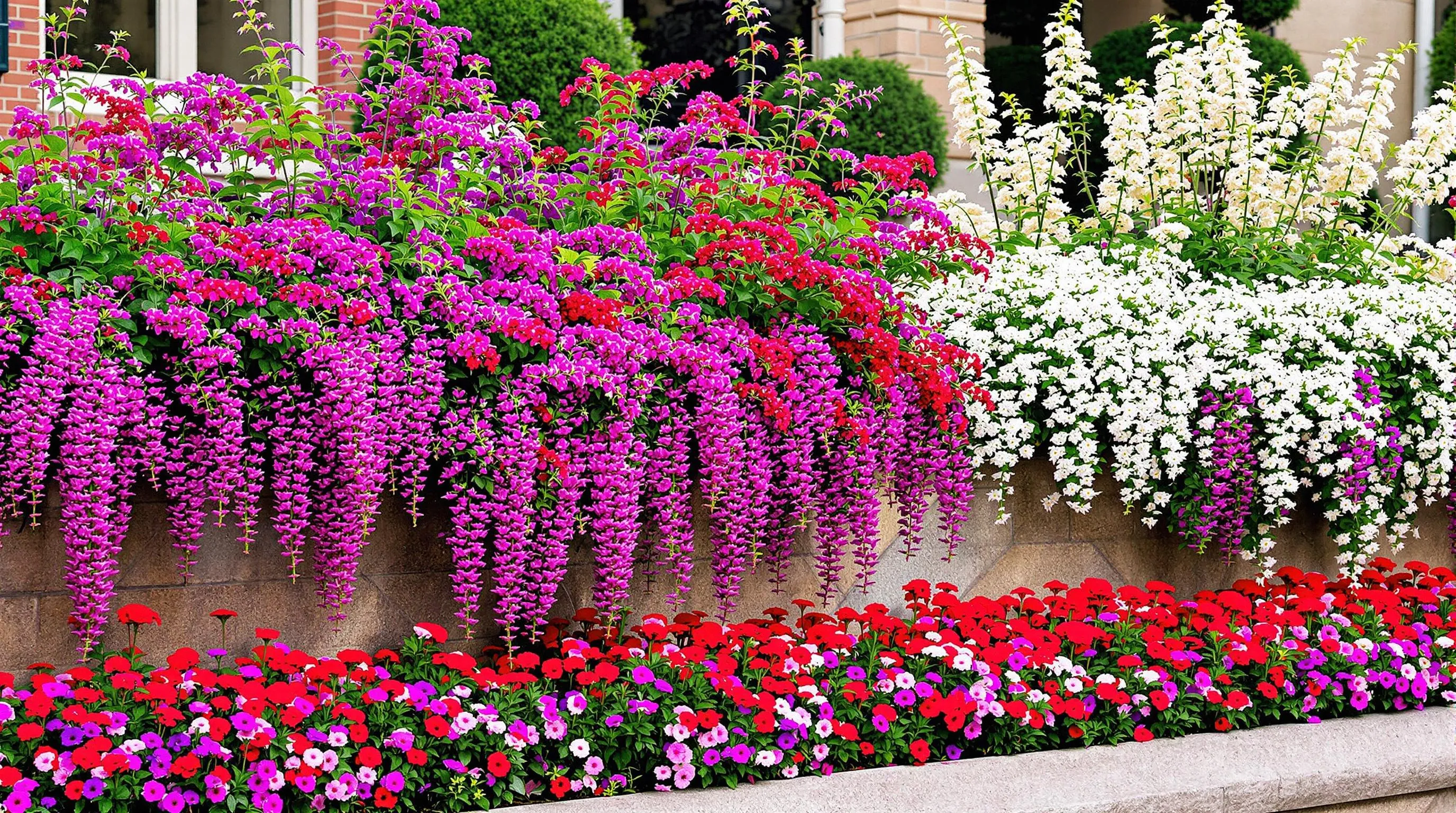
Verbena stands out as one of the most reliable annuals for gardeners seeking nonstop color in hot conditions. This versatile bloomer thrives when other flowers wilt, producing clusters of small, vivid flowers in shades of purple, pink, red, and white. You’ll appreciate verbena’s drought tolerance once established and its ability to attract butterflies and hummingbirds throughout the growing season.
Trailing Verbena for Ground Cover
Trailing verbena varieties like Verbena ‘Superbena’ and ‘Homestead Purple’ create stunning cascades of color that spill over walls, containers, and hanging baskets. These low-growing spreaders can reach 6-12 inches in height while extending 2-3 feet outward, making them perfect for softening hardscape edges and filling empty spaces. Plant trailing verbena 12-18 inches apart in well-draining soil to prevent root rot, and you’ll be rewarded with waves of blooms from spring until frost. For best performance, position these sun-lovers where they’ll receive at least 6 hours of direct sunlight daily and trim them back by one-third mid-season to encourage fresh growth and renewed flowering.
Upright Verbena for Border Plantings
Upright verbena varieties offer architectural interest and vertical accent in garden beds and borders. Types like Verbena bonariensis (Brazilian verbena) reach impressive heights of 3-4 feet while maintaining a see-through, airy quality that complements rather than overwhelms neighboring plants. Their slender stems topped with tiny purple flower clusters create movement and texture in the garden. Unlike their trailing cousins, upright verbenas self-seed readily, often returning year after year in warmer zones. Plant these statuesque bloomers 18-24 inches apart in full sun locations, where they’ll serve as structural elements that attract pollinators. Their drought tolerance makes them ideal companions for other heat-loving annuals like zinnias and lantana, creating combination plantings that thrive during summer’s hottest days.
Selecting Begonias for Shade to Partial Sun Areas

Begonias offer a perfect solution for bringing vibrant color to those challenging shady spots in your garden where many flowering annuals struggle. With their diverse varieties and impressive bloom longevity, begonias provide reliable color from spring until frost with minimal maintenance.
Wax Begonias for Reliability
Wax begonias (Begonia semperflorens) stand out as the workhorses of shaded gardens, delivering dependable color throughout the growing season. These compact plants typically reach 6-12 inches in height and feature glossy, rounded leaves that add visual interest even when not in bloom. You’ll find wax begonias in vibrant shades of pink, red, and white, with both green and bronze-leaved varieties available. Plant them 8-10 inches apart in well-draining soil amended with organic matter for best results. The ‘Cocktail’ series offers exceptional heat tolerance with striking bronze foliage, while the ‘Ambassador’ series provides larger blooms on sturdy plants that resist weather damage. Wax begonias require minimal deadheading and perform beautifully in containers, borders, or mass plantings, maintaining their neat appearance throughout the season.
Tuberous Begonias for Dramatic Blooms
Tuberous begonias (Begonia × tuberhybrida) deliver show-stopping flowers that resemble roses or carnations, creating focal points in your shade garden. These stunning plants produce blooms up to 4-6 inches across in a spectrum of colors including salmon, yellow, orange, pink, and white. The ‘Nonstop’ series lives up to its name with continuous flowering from late spring until frost, even in challenging conditions. Plant tuberous begonias in hanging baskets or containers where their pendulous blooms can be appreciated at eye level. They prefer rich, well-draining soil and consistent moisture without waterlogging. For maximum blooming, fertilize every two weeks with a balanced water-soluble fertilizer. While slightly more demanding than wax begonias, tuberous varieties reward your efforts with unmatched flower size and sumptuous double blooms that transform shaded areas into garden showpieces.
Planting Lantana for Drought-Tolerant Color Clusters
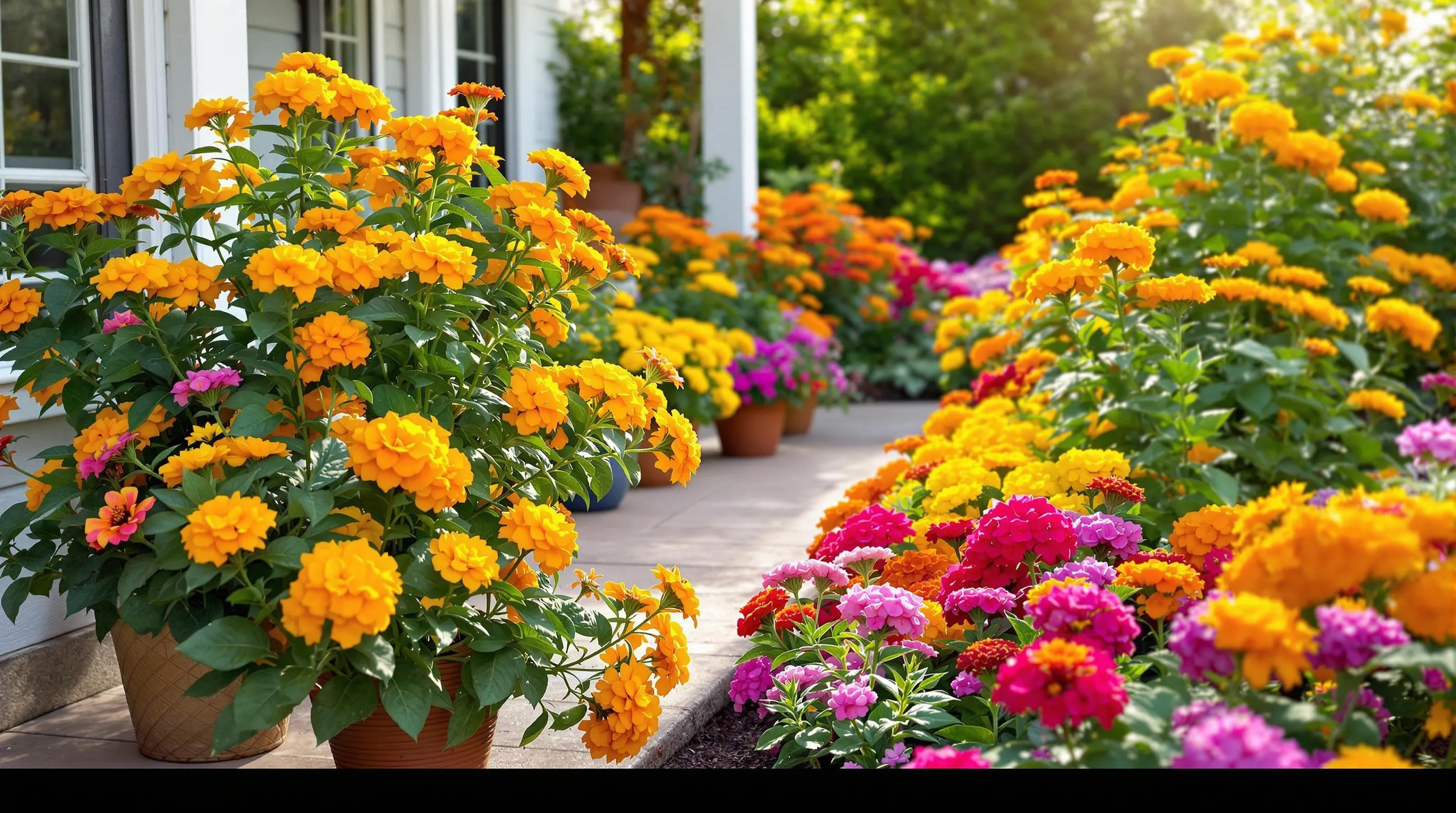
Lantana stands out as one of the most resilient and vibrant annuals you can add to your garden, especially if you live in a hot, dry climate. These colorful plants produce clusters of small, tubular flowers that change colors as they mature, creating a captivating multi-hued effect in a single bloom cluster. Their exceptional drought tolerance and heat resistance make them perfect for gardeners looking to maintain color without constant watering.
Compact Varieties for Containers
Compact lantana varieties offer spectacular color for containers, window boxes, and small spaces. Lantana ‘Bandana’ and ‘Bandito’ series typically grow just 12-16 inches tall and wide, making them ideal for pots on patios and balconies. The ‘Little Lucky’ series stays even smaller at 8-12 inches tall with neat, mounded growth habits. Plant these compact varieties in well-draining potting mix and position containers in full sun for maximum flowering. Even though their small size, these varieties deliver the same drought tolerance as their larger cousins—water only when the top inch of soil feels dry, and fertilize monthly with a balanced flower fertilizer to maintain continuous blooms from spring until frost.
Spreading Varieties for Garden Beds
Spreading lantana varieties create stunning ground coverage and work beautifully as flowering borders or mass plantings. The ‘Landmark’ series and ‘New Gold’ can spread 3-4 feet wide while remaining under 2 feet tall, quickly filling empty garden spaces with waves of color. ‘Miss Huff’ and ‘Chapel Hill Yellow’ varieties offer exceptional cold hardiness, sometimes returning in warmer zones after mild winters. When planting in garden beds, space plants 2-3 feet apart to allow for their spreading habit. These varieties thrive in poor, sandy soils where other flowers struggle and actually bloom more profusely when not overwatered. Their sprawling growth habit also makes them effective for erosion control on slopes, combining practicality with months of nonstop color.
Maintaining Your Annual Garden for Continuous Flowering
Transform your outdoor space into a kaleidoscope of color with these amazing annual varieties. You’ll enjoy months of vibrant blooms with minimal effort by incorporating these hardworking plants into your garden design. Whether you’re dealing with scorching sun heat-resistant lantanas or shady spots perfect for lush begonias there’s an annual to suit every corner of your industry.
Remember that while these plants are naturally prolific bloomers a bit of basic care goes a long way. Regular watering fertilizing and occasional deadheading will keep your garden looking its best. By selecting a mix of these spectacular annuals you’ll create a ever-changing display that delivers nonstop color from spring until the first frost.





